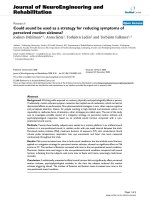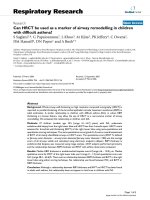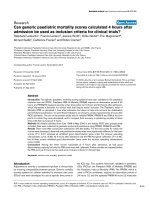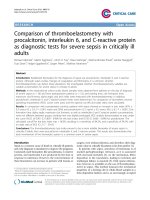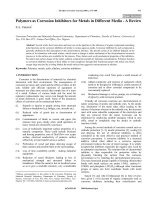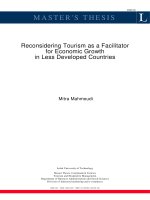Water-soluble carboxymethylchitosan used as corrosion inhibitor for carbon steel in saline medium
Bạn đang xem bản rút gọn của tài liệu. Xem và tải ngay bản đầy đủ của tài liệu tại đây (1.12 MB, 6 trang )
Carbohydrate Polymers 205 (2019) 371–376
Contents lists available at ScienceDirect
Carbohydrate Polymers
journal homepage: www.elsevier.com/locate/carbpol
Water-soluble carboxymethylchitosan used as corrosion inhibitor for carbon
steel in saline medium
T
Ruza Gabriela Medeiros de Arẳjo Macedoa, Nívia do Nascimento Marquesa, Josealdo Tonholob,
⁎
Rosangela de Carvalho Balabana,
a
b
Universidade Federal do Rio Grande do Norte – UFRN, Natal, RN, Brazil
Universidade Federal de Alagoas – UFAL, Maceió, AL, Brazil
A R T I C LE I N FO
A B S T R A C T
Keywords:
Carboxymethylchitosan
Corrosion inhibitor
Carbon steel
Chlorides
Polarization
EIS
Biodegradability and ecotoxicity of products used in oil industry are of great relevance and corrosion inhibitor
could not be an exception. In earlier reports, chitosan and some derivatives were evaluated as corrosion inhibitors at acid pH, mainly due to polymer solubility. An eco-friendly corrosion inhibitor with water solubility in
all pH range should be ideal, as well as that could act under the high salinity of oil field environment. Thus,
herein is presented the performance of a water-soluble carboxymethylchitosan (CMC) as corrosion inhibitor in
presence of chlorides (3.5% NaCl) in 1020 carbon steel, without any addition of acid or base. CMC showed good
properties as corrosion inhibitor in media containing Cl−, and behaved as an anodic inhibitor. CMC exhibited
inhibitory efficiency of about 80% and 67%, according to Tafel curve and electrochemical impedance, respectively, which was attributed to chemisorption mechanism (ΔGads ≈ −45 kJ/mol).
1. Introduction
Crude oil, a complex mixture of hydrocarbons, is the basis for energy savings around the world. In many cases, the presence of these
liquid hydrocarbons may help to reduce corrosion as a result of their
ability to form highly adherent films on the metal surface (Heakal,
Fouda, & Radwan, 2011). However, in other cases, the presence of
impurities such as H2S, CO2, naphthenic acids and chlorides can promote the corrosion of steel pipes and equipment used in the exploration, production, transportation and petroleum refining process
(Ghassem Mahjani, Neshati, Parvaneh Masiha, & Jafarian, 2007; Heakal
et al., 2011). The main cause of corrosion in carbon steel by pitting is
related to the presence of chloride ions (Ghassem Mahjani et al., 2007),
due to its aggressive nature that is attributed to its small ionic radius,
which allows a greater diffusion between the monolayers formed in the
metal surface Corrosion in the petroleum industry can be generally
mitigated by the use of inhibitors, which are chemicals that retard the
rate of corrosion of the metal (Heakal et al., 2011).
In general, the chemicals used as inhibitors contain in their structure phosphonates and sulfonates, which, although efficient, have low
biodegradability (Frenier & Ziauddin, 2008). Therefore, frequent use
can result in damage to the environment. One of the great challenges of
the industry has been to develop chemicals that are environmentally
⁎
safe and effective in inhibiting corrosion under the conditions of each
well. The efficiency of these organic inhibitors of corrosion is related to
the presence of polar functions containing S, O or N atoms, which are
centers for the adsorption process. In addition to these compounds,
there are also polymers or macromolecules that function as good corrosion inhibitors, not only by the presence of functional groups (eOH,
eCOOH, eNH2, etc.) but also by the size of the polymer chains, which
favors the adsorption in the surface (Benchikh, Aitout, Makhloufi,
Benhaddad, & Saidani, 2009; Darmokoesoemo, Suyanto, Anggara,
Amenaghawon, & Kusuma, 2018; Eduok, Ohaeri, & Szpunar, 2018;
Mobin & Rizvi, 2017; Sun, Wang, Wang, & Yan, 2018; Umoren,
AlAhmary, Gasem, & Solomon, 2018).
The most common corrosion inhibitor polymers are derivatives of
polyamines, polyvinylamides, polyaspartates and other amino acids,
polyaniline, polycarboxylates/polycarboxylic acids and polysaccharides (Tiu & Advincula, 2015). In general, corrosion inhibitor
selection criteria are not limited to their chemical structure but also to
their environmental impact, which should be low. Due to the worldwide interest in environmental safety, the use of toxic chemicals and
the operations in which they are generated have been minimized. For
this reason, natural products such as organic acids, vitamins, plant
extract and natural water-soluble polymers have been studied as corrosion inhibitors (Bello et al., 2010; El-Haddad, 2014; Jenkins & Harris,
Corresponding author.
E-mail address: (R.d.C. Balaban).
/>Received 15 June 2018; Received in revised form 23 October 2018; Accepted 23 October 2018
Available online 26 October 2018
0144-8617/ © 2018 Elsevier Ltd. All rights reserved.
Carbohydrate Polymers 205 (2019) 371–376
R.G.M.d.A. Macedo et al.
2011; Umoren & Eduok, 2016).
In particular, many papers have been describing the performance of
chitosan or its derivatives as corrosion inhibitors and the obtained results have been considered very promising (Cheng, Chen, Liu, Chang, &
Yin, 2007; Eduok et al., 2018; El-Haddad, 2013; Giuliani et al., 2018;
Menaka & Subhashini, 2017; Sangeetha, Meenakshi, & Sundaram,
2016; Srivastava et al., 2018; Umoren et al., 2018; Wan, Feng, Hou, &
Li, 2016). Chitosan is a polymer generally obtained by desacetylation of
chitin, a polysaccharide extracted from the shells of crustaceans,
exoskeleton of many arthropods and some fungi. Mainly due to polymer
solubility, the studies have been restricted to acid-induced conditions,
mostly in sweet water. However, in order to avoid poor solubility or
precipitation, which would lead to inefficient inhibition, financial loss
and reduction of petroleum production, oil industry requires a corrosion inhibitor water-soluble in all pH range and that could be applied
under typical high salinity encountered in the field.
Thus, the main objective of this work is to evaluate the behavior of a
water-soluble carboxymethylchitosan as a preventive inhibitor of the
corrosion processes in pipelines used in the oil well installations of
Brazil, considering the high salinity of 3.5% NaCl in the medium.
Fig. 2. (a) Polarization curves obtained with the 1020 C-steel electrode in 3.5%
NaCl in the presence and absence of different concentrations of the CMC inhibitor at 25 °C and υ = 1 mVs−1; (b) Curve of corrosion potential as a function
of CMC concentration.
2. Experimental
calculated the corrosion current density and corrosion rate. EIS measurements were carried out using AC signals of amplitude 10 mV peak
to peak at the open circuit potential in the frequency range 10 kHz a
100 mHz. The electrical equivalent circuit was estimated from the EIS
Spectrum Analyser software, which uses the method of complex nonlinear least squares to approximate the theoretical data of experimental.
The quality of the treatment of experimental data was evaluated
through a parameter set to Chi-square, x2, which indicates a good approximation the smaller its value. For this study, all the approaches
were estimated with values in the order.
2.1. Chemical and materials
¯ v = 2.28 × 104 g/mol
The water-soluble carboxymethylchitosan (M
and degree of carboxymethylation = 0.55) was prepared as described
by Chen and Park (2003), however, with some changes. The temperature was fixed at 10 °C and the water/isopropanol ratio used was 2/8
(Fig. 1). The chemical composition of carbon steel used in the study is
the following (weight %) C – 0.18, S – 0.05, P – 0.04, Mn – 0.85. The
coupon was embedded in epoxy resin in a glass tube and the electrical
count was performed through a copper wire. Prior to all measurements,
the exposed surface area of the electrode (0.308 cm2) was abraded with
series of emery papers up to 1200 grade, rinsed with double distilled
water, ethanol and dried air. This was used as the working electrode
during the electrochemical methods. The aggressive solution used was
3.5% NaCl diluted in double distilled water. Stock solution of carboxymethylchitosan (1 g/L) was prepared in double distilled water. The
concentration range of CMC used in this work was 10–80 ppm.
3. Results and discussion
3.1. Electrochemical measurements
3.1.1. Potentiondynamic polarization
Potentiondynamic polarization curves for 1020 C-steel in 3.5% NaCl
in absence and presence of different concentrations of CMC at 25 °C are
shown in Fig. 2. The percentage inhibition efficiency (ε %) and the
degree of surface coverage (θ), were calculated from the Eq. (1) (Wang,
Liu, & Xin, 2004; Zhang, Gong, Yu, & Du, 2011).
2.2. Electrochemical measurements
A conventional three-electrode cell, composed of a working electrode carbon steel 1020, Ag/AgCl reference electrode and contra-electrode was used for electrochemical measures. The experiments were
performed in a Metrom Instrument Autolab PGSTAT 30 Potentiostat/
Galvanostat with FRA – Frequency Response Analyzer, which were held
the following electrochemical techniques: Linear Voltammetry and
Electrochemical Impedance Spectroscopy. Initially, the electrode was
preconditioned on open circuit potential (OCP) for 30 min at a temperature of ± 25 °C for all trials. Potentiodynamic polarization measurements were performed in a range of ± 100 mV of OCP with nearstationary scanning of 1 mVs−1. From the polarization curve, were
I
ε (%) = θ * 100 = ⎡
⎢
⎣
0
corr − Icorr ⎤
⎥
I 0 corr
⎦
* 100
(1)
Where I°corr and Icorr are the corrosion current densities in the absence
and the presence of the inhibitor, respectively. In Fig. 1 is possible to
observe a displacement in the corrosion potential by the addition of the
carboxymethylchitosan to the medium, indicating that the polymer has
a strong potential for inhibition of corrosion by chloride. The corrosion
potential of NaCl 3.5% was −501 mV. When 10 ppm of CMC was
added, this potential was shifted to −484 mV. And at each concentration increase, that potential was shifted to more positive regions,
Fig. 1. Synthesis of carboxymethylchitosan.
372
Carbohydrate Polymers 205 (2019) 371–376
R.G.M.d.A. Macedo et al.
Table 1
Electrochemical parameters acquired from Tafel extrapolation for 1020 C-steel
processes in the absence and presence of carboxymethylchitosan, at 25 °C.
CMC concentration
(ppm)
Ecorr
(mV)
Icorr
(μA/cm2)
T
(mm/year)
θ
ε (%)
0
10
20
40
80
−501
−484
−472
−467
−444
2.604
2.102
1.579
0.468
0.458
8.258e−3
4.070e−3
3.024e−3
1.501e−3
1.191e−3
–
0.507
0.521
0.818
0.855
–
50.71
52.07
81.82
85.57
reaching −444 mV at the concentration of 80 ppm. This result suggests
an anodic behavior. From these curves, it was possible to estimate,
through the extrapolation of the Tafel curve, the electrochemical
parameters related to this system, such as current density and corrosion
rate, which are presented in Table 1. The obtained data indicated that
the corrosion rate reduces with increasing concentration of CMC in the
system, reaching 8 times less than pure brine for the maximum concentration of inhibitor. The corrosion current is also reduced with increasing inhibitor concentration, thus suggesting the formation of a
protective layer that hinders the permeation of ions through the electric
double layer in order to reach the metal surface. Therefore, it is suggested that CMC shows a good performance as a corrosion inhibitor.
Table 1 shows the electrochemical parameters that give evidences
that the degree of coverage of the metal rise with increasing concentration of the CMC, suggesting a possible chemical adsorption on
metal surface.
3.1.2. Electrochemical impedance spectroscopy (EIS)
The impedance responses of 1020 c-steel in solutions of 3.5% NaCl
in absence and presence of CMC in various concentrations, at 25 °C, are
represented in Fig. 3, at Nyquist and Bode plots. The Nyquist diagram is
typical for a system of carbon steel corrosion in 3.5% NaCl solution (ElHaddad, 2014). Although it is not formed a perfect semi-circle, can be
seen that the addition of CMC causes the formation of a bow more
capacitive, compared to the curve of 3.5% NaCl solution, which induces
an increase in diameter of the arc. The intersection of the curve with the
x-axis (Zr) provides data of polarization resistance, it can be said that
the relationship between diameter and increase resistance to polarization is direct. It is observed that the polarization resistance increases
with the increase of CMC concentration.
The Bode curves represented in Fig. 3(c) show that the addition of
the inhibitor did not cause a significant displacement to a region of
greater impedance when compared to the curve of the electrolyte,
however a slight increase in the polarization resistance of 1020 carbon
steel was observed with the increase of CMC concentration, with the
highest displacement reached when using the polymer concentration of
80 ppm, which suggests a higher adsorption on the metal surface.
The cross of the line, which determines the slope of the curve, with
Log ω = 0 gives the electric double layer capacitance through Eq. (2)
(Umoren, Obot, Madhankumar, & Gasem, 2015; Wang, Liu, Bin, & Xin,
2004).
|Z| =
1
Cdl
Fig. 3. Nyquist plots (a) and Bode plots (b,c) of 1020 c-steel in uninhibited and
inhibited 3.5% NaCl solutions containing various concentrations of CMC, at
25 °C.
(2)
Table 2
Data of the load transfer resistance (Rtc) and the electric double layer capacitance (Cdl) for CMC after treatment of the experimental data.
It is possible to extract from this curve the data concerning the resistance of the electrolytic solution (Re) and resistance to polarization
(Rp). The difference between these two provides the load transfer resistance (Rtc). The load transfer resistance (Rtc) and the electric double
layer capacitance (Cdl) obtained experimentally after treatment of the
data with specific software are presented in Table 2. It is evidenced that
the addition of CMC causes an increase in the transfer resistance of
charge and consequently a reduction in the capacitance of the double
electric layer. These low Cdl values may be associated with an increase
in the thickness of the electric double layer (Zhang et al., 2011),
373
Inhibitor Concentration (ppm)
Rtc (Ωcm2)
Cdl (μF/cm2)
0
10
20
40
80
67.74
110.07
117.39
146.21
210.68
0.142
0.0921
0.0871
0.0708
0.0500
Carbohydrate Polymers 205 (2019) 371–376
R.G.M.d.A. Macedo et al.
suggesting that the inhibitor molecules adsorb at the metal/solution
interface.
In the Bode (Log ω vs phase angle) curves for CMC at different
concentrations is possible to observe the existence of two phase constants when CMC is added because the diagram shows two distinct
peaks. The first peak, located in the low frequency region, can be attributed to the metal/electrolyte interaction. It is possible to observe
that the increase in the concentration of CMC increases the phase angle,
which contributes to a better protection of the metal. The second peak,
a region of high frequency, can indicate a higher resistance of the steel,
associated to the process of adsorption of the film. The maximum point
of the curve is related to the polarization resistance, according to Eq. (3)
(Umoren et al., 2015; Wang et al., 2004). By the Eq. (3), if Rp (polarization resistance) is increased and Re (solution resistance) is kept
constant, θmax will increase. Thus, it is observed that the concentration
of 80 ppm presents greater polarization resistance and probably higher
adsorption power, compared to the other concentrations, thus making
the steel more protected.
θmáx = arctg
Table 3
Data on efficiency (ε) and degree of coverage (θ) of the CMC inhibitor obtained
by extrapolation of the Tafel curve and Electrochemical Impedance, at 25 °C.
CMC
TAFEL
10
20
40
80
EIS
10
20
40
80
C (M)
θ
C (M)/θ
4.386e−7
8.772e−7
1.754e−6
3.508e−6
0.507
0.521
0.818
0.855
8.6508e−7
1.6836e−6
2.1447e−6
4.1038e−6
4.386e−7
8.772e−7
1.754e−6
3.508e−6
0.384
0.423
0.536
0.678
1.1421e−6
2.0737e−6
3.2731e−6
5.1751e−6
Electrochemical technique
Inhibitor
kads
(M−1)
ΔGads
(KJ/mol)
Tafel
EIS
CMC
1.8219e6
1.2143e6
−45.666
−44.661
(3)
Inhibition efficiency was computed from the electrochemical impedance spectroscopy measurements using the Eqs. (4) and (5).
Rtc0
Rtc
(4)
%ε = θ * 100
(5)
θ=1−
C (ppm)
Table 4
Data of adsorption constant (kads) and free energy of Gibbs (ΔGads) for the inhibitor CMC in NaCl 3.5% obtained by extrapolation of the Tafel curve and
electrochemical impedance, at 25 °C.
Rp
2 R e (R e + Rp)
Inhibitor
θ
= kads C
θ−1
(6)
Rearranging,
C
1
=C+
θ
K ads
Where, Rtc° and Rtc correspond to the charge transfer resistance without
and with inhibitor, respectively.
The impedance spectra were analyzed by fitting an equivalent
electric circuit using the EIS Spectrum Analyzer Software, as shown in
Fig. 4. CMC followed the same mechanism of action for all concentrations studied. In this way, we have that R1 represents the resistance of
the solution, CPE1 is the electric double layer capacitance, R2 is the
charge transfer resistance and Ws1 is the semi-finite linear diffusion
resistance (Warburg).
(7)
Where C is the concentration of the inhibitor and θ is the fraction of the
surface covered.
Eq. (7) provides a linearity between the values of C/θ and C. Since
ΔGads is the free energy of adsorption and kads the equilibrium adsorption constant, it is possible to calculate this energy through Eq. (8)
(Umoren & Eduok, 2016; Umoren et al., 2015). These parameters were
calculated and are described in Table 4.
1
exp −ΔG RT
55,5
(
)
3.2. Adsorption isotherm
kads =
To obtain more information on the mode of adsorption of CMC on
the metal surface, the data acquired from the extrapolation of the Tafel
curve and electrochemical impedance spectroscopy were tested by
several models, and the best correlation was obtained with the
Langmuir isotherm. According to this isotherm, θ is related to concentration through Eqs. (6) and (7) (Abdallah, El-Etre, Soliman, &
Mabrouk, 2006; El-Haddad, 2014; Wang et al., 2004). The values of C
and C/θ are represented in Table 3 for each technique studied.
Fig. 5 shows the adsorption isotherms according to the Langmuir
model obtained by the two experimental techniques used in the study.
According to the Fig. 4, it is possible to observe linearity between C/θ
and C for both techniques, with correlation values of 0.9902 and 0.9925
for Tafel and EIS, respectively, indicating an optimal correlation.
For a corrosion inhibitor to exhibit good adsorption and thus promote good inhibition, it must be adhered spontaneously to the metal
surface. As the spontaneity is determined by the value of ΔGads, which
(8)
Fig. 4. (a) Overlap of experimental and theoretical fitting of
Nyquist curves, at 10, 40 and 80 ppm of CMC, and (b) proposed equivalent electric circuit for the validation of the impedance curves of the system under study. R1 = solution resistance,
CPE1 = electric
double
layer
capacitance,
R2 = charge transfer resistance and Ws1 = semi-finite linear
diffusion resistance.
374
Carbohydrate Polymers 205 (2019) 371–376
R.G.M.d.A. Macedo et al.
groups or oxygen atoms in the hydroxyl and carboxyl groups and the
empty 3d orbitals of iron atoms on the metallic surface (Fig. 6) (Yoo,
Kim, Chung, Kim, & Kim, 2013; Wan et al., 2016). This result indicates
that the inhibitor molecules can form a protective layer at the metal/
solution interface.
4. Conclusions
The water-soluble CMC is an excellent corrosion inhibitor in media
of 3.5% NaCl, since the efficiency results were 85%, determined by the
extrapolation of the Tafel curve, at the maximum concentration studied
(80 ppm). According to data from the extrapolation of the Tafel curve,
the CMC behaves as an anodic inhibitor, as the polarization curves were
shifted to a region of more positive potentials.
The values of ΔGads obtained by the extrapolation techniques of the
Tafel curve and electrochemical impedance are consistent and suggest a
mechanism of chemisorption, since this energy is greater than
|40| kJmol−1, which suggests a strong adsorption of the organic molecule, carboxymethylchitosan, on the metallic surface. The performance exhibited under NaCl medium, coupled to the water solubility of
CMC, indicates that it has great potential as corrosion inhibitor of
carbon steel in oil field environment.
Acknowledgement
Fig. 5. Langmuir model adsorption isotherm and correlation curve obtained by
the extrapolation of Tafel (a) and EIS (b) for the different concentrations of
CMC in 1020 C-steel and 3.5% NaCl, at 25 °C.
This study was financed in part by the Coordenaỗóo de
Aperfeiỗoamento de Pessoal de Nớvel Superior - Brasil (CAPES) Finance Code 001.
References
Abdallah, M., El-Etre, A. Y., Soliman, M. G., & Mabrouk, E. M. (2006). Some organic and
inorganic compounds as inhibitors for carbon steel corrosion in 3.5% NaCl solution.
Anti-Corrosion Methods and Materials, 53(2), 118–123.
Bello, M., Ochoa, N., Balsamo, V., López-Carrasquero, F., Coll, S., Monsalve, A., et al.
(2010). Modified cassava starches as corrosion inhibitors of carbon steel: An electrochemical and morphological approach. Carbohydrate Polymers, 82(3), 561–568.
Benchikh, A., Aitout, R., Makhloufi, L., Benhaddad, L., & Saidani, B. (2009). Soluble
conducting poly(aniline-co-orthotoluidine) copolymer as corrosion inhibitor for
carbon steel in 3% NaCl solution. Desalination, 249(2), 466–474.
Chen, X. G., & Park, H. J. (2003). Chemical characteristics of O-carboxymethyl chitosans
related to the preparation conditions. Carbohydrate Polymers, 53(4), 355–359.
Cheng, S., Chen, S., Liu, T., Chang, X., & Yin, Y. (2007). Carboxymethylchitosan + Cu2+
mixture as an inhibitor used for mild steel in 1 M HCl. Electrochimica Acta, 52(19),
5932–5938.
Darmokoesoemo, H., Suyanto, S., Anggara, L. S., Amenaghawon, A. N., & Kusuma, H. S.
(2018). Application of carboxymethyl chitosan-benzaldehyde as anticorrosion agent
on steel. International Journal of Chemical Engineering, 2018 4397867.
Eduok, U., Ohaeri, E., & Szpunar, J. (2018). Electrochemical and surface analyses of X70
steel corrosion in simulated acid pickling medium: Effect of poly (N-vinyl imidazole)
grafted carboxymethyl chitosan additive. Electrochimica Acta, 278, 302–312.
El-Haddad, M. N. (2013). Chitosan as a green inhibitor for copper corrosion in acidic
medium. International Journal of Biological Macromolecules, 55, 142–149.
El-Haddad, M. N. (2014). Hydroxyethylcellulose used as an eco-friendly inhibitor for
1018 c-steel corrosion in 3.5% NaCl solution. Carbohydrate Polymers, 112, 595–602.
Frenier, W. W., & Ziauddin, M. (2008). Formation, removal, and inhibition of inorganic
scale in the oilfield environment. In N. Wolf, & R. Hartman (Eds.). Society of petroleum
engineers.
Ghassem Mahjani, M., Neshati, J., Parvaneh Masiha, H., & Jafarian, M. (2007).
Electrochemical noise analysis for estimation of corrosion rate of carbon steel in
crude oil. Anti-Corrosion Methods and Materials, 54(1), 27–33.
Giuliani, C., Pascucci, M., Riccucci, C., Messina, E., Salzano de Luna, M., Lavorgna, M.,
et al. (2018). Chitosan-based coatings for corrosion protection of copper-based alloys:
A promising more sustainable approach for cultural heritage applications. Progress in
Organic Coatings, 122, 138–146.
Heakal, F. E. T., Fouda, A. S., & Radwan, M. S. (2011). Some new Thiadiazole derivatives
as corrosion inhibitors for 1018 carbon steel dissolution in sodium chloride solution.
International Journal of Electrochemical Science, 6(8), 3140–3163.
Hu, L., Zhang, S., Li, W., & Hou, B. (2010). Electrochemical and thermodynamic investigation of diniconazole and triadimefon as corrosion inhibitors for copper in
synthetic seawater. Corrosion Science, 52(9), 2891–2896.
Jenkins, S., & Harris, K. (2011). Biodegradation and testing of scale inhibitors. Chemical
Engineering, 118(4).
Menaka, R., & Subhashini, S. (2017). Chitosan Schiff base as effective corrosion inhibitor
for mild steel in acid medium. Polymer International, 66(3), 349–358.
Mobin, M., & Rizvi, M. (2017). Polysaccharide from Plantago as a green corrosion
Fig. 6. Scheme of CMC adsorption mechanism onto metal surface.
must be less than zero, it can be concluded that the CMC adsorbs
spontaneously on the metal surface. The ΔG values by the Tafel and EIS
techniques were −45.666 KJ/mol and −44.661 KJ/mol, respectively.
The presence of eCOO− and eNH2 groups in the CMC chemical
structure may have favored interactions with the metal ions (Fe2+),
promoting strong adsorption of the inhibitor on the metal surface
(Benchikh et al., 2009; Darmokoesoemo et al., 2018; Eduok et al., 2018;
Mobin & Rizvi, 2017; Sun et al., 2018; Umoren et al., 2018) and,
consequently, a corrosion inhibition efficiency of 85%, for the 80 ppm
concentration of the inhibitor, since it has a high value of kads
(1.8219e6).
According to Hu, Zhang, Li, and Hou, (2010) and Wang et al.
(2004), when the absolute value of ΔGads is below 20 kJmol−1, a
physisorption process occurs; and an absolute value of ΔGads above
40 kJ mol−1 indicates a chemisorption process, and between the two
values there are two processes. In this way, it can be inferred that the
CMC follows the mechanism of chemisorption, since the values of ΔGads
are greater than |40| kJmol−1. Thus, it is suggested a sharing or transfer
of organic molecules to the metal surface forming a coordinate-like
bond. This phenomenon was confirmed by both techniques studied.
Literature states that the chemisorption force derives from the interaction between the lone electron pairs of nitrogen atoms of amino
375
Carbohydrate Polymers 205 (2019) 371–376
R.G.M.d.A. Macedo et al.
inhibitors for metal substrates in different media: A review. Carbohydrate Polymers,
140, 314–341.
Umoren, S. A., Obot, I. B., Madhankumar, A., & Gasem, Z. M. (2015). Performance
evaluation of pectin as ecofriendly corrosion inhibitor for X60 pipeline steel in acid
medium: Experimental and theoretical approaches. Carbohydrate Polymers, 124,
280–291.
Wan, K., Feng, P., Hou, B., & Li, Y. (2016). Enhanced corrosion inhibition properties of
carboxymethyl hydroxypropyl chitosan for mild steel in 1.0 M HCl solution. RSC
Advances, 6(81), 77515–77524.
Wang, H. L., Liu, R., Bin, & Xin, J. (2004). Inhibiting effects of some mercapto-triazole
derivatives on the corrosion of mild steel in 1.0 M HC1 medium. Corrosion Science,
46(10), 2455–2466.
Yoo, S.-H., Kim, Y.-W., Chung, K., Kim, N.-K., & Kim, J.-S. (2013). Corrosion inhibition
properties of triazine derivatives containing carboxylic acid and amine groups in
1.0 M HCl solution. Industrial & Engineering Chemistry Research, 52(32), 10880–10889.
Zhang, J., Gong, X. L., Yu, H. H., & Du, M. (2011). The inhibition mechanism of imidazoline phosphate inhibitor for Q235 steel in hydrochloric acid medium. Corrosion
Science, 53(10), 3324–3330.
inhibitor for carbon steel in 1 M HCl solution. Carbohydrate Polymers, 160, 172–183.
Sangeetha, Y., Meenakshi, S., & Sundaram, C. S. (2016). Interactions at the mild steel acid
solution interface in the presence of O-fumaryl-chitosan: Electrochemical and surface
studies. Carbohydrate Polymers, 136, 38–45.
Srivastava, V., Chauhan, D. S., Joshi, P. G., Maruthapandian, V., Sorour, A. A., & Quraishi,
M. A. (2018). PEG-functionalized chitosan: A biological macromolecule as a novel
corrosion inhibitor. ChemistrySelect, 3(7), 1990–1998.
Sun, H., Wang, H., Wang, H., & Yan, Q. (2018). Enhanced removal of heavy metals from
electroplating wastewater through electrocoagulation using carboxymethyl chitosan
as corrosion inhibitor for steel anode. Environmental Science Water Research &
Technology, 4, 1105–1113.
Tiu, B. D. B., & Advincula, R. C. (2015). Polymeric corrosion inhibitors for the oil and gas
industry: Design principles and mechanism. Reactive & Functional Polymers, 95,
25–45.
Umoren, S. A., AlAhmary, A. A., Gasem, Z. M., & Solomon, M. M. (2018). Evaluation of
chitosan and carboxymethyl cellulose as ecofriendly corrosion inhibitors for steel.
International Journal of Biological Macromolecules, 117, 1017–1028.
Umoren, S. A., & Eduok, U. M. (2016). Application of carbohydrate polymers as corrosion
376


